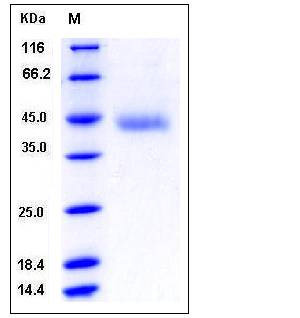Mouse OMGP / OMG Protein (aa 1-245, His Tag)
RP23-67E18.6, LNGFR, Tnfrsf16, p75, p75NGFR, p75NTR
- 100ug (NPP3432) Please inquiry
| Catalog Number | P50686-M08H1 |
|---|---|
| Organism Species | Mouse |
| Host | Human Cells |
| Synonyms | RP23-67E18.6, LNGFR, Tnfrsf16, p75, p75NGFR, p75NTR |
| Molecular Weight | The secreted recombinant mouse OMGP (aa 1-245) comprises 232 amino acids and has a calculated molecular mass of 27 kDa. As a result of glycosylation, the recombinant protein migrates as an approximately 44 kDa band in SDS-PAGE under reducing conditions. |
| predicted N | Ile 25 |
| SDS-PAGE |  |
| Purity | > 95 % as determined by SDS-PAGE |
| Protein Construction | A DNA sequence encoding the amino acids (Met 1-Thr 245) of mouse OMGP (Q63912) was expressed, with a C-terminal polyhistidine tag. |
| Bio-activity | |
| Research Area | Developmental Biology |Embryogenesis |Germ Layer Formation |Ectoderm Marker |
| Formulation | Lyophilized from sterile PBS, pH 7.4 1. Normally 5 % - 8 % trehalose and mannitol are added as protectants before lyophilization. Specific concentrations are included in the hardcopy of COA. |
| Background | Mouse oligodendrocyte-myelin glycoprotein, also known as OMG and OMGP, is a cell membrane protein which contains eight LRR (leucine-rich) repeats. OMG / OMGP is a glycosylphosphatidylinositol-anchored protein expressed by neurons and oligodendrocytes in the central nervous system (CNS). OMG / OMGP is a cell adhesion molecule contributing to the interactive process required for myelination in the central nervous system. OMG / OMGP play roles in both the developing and adult central nervous system. OMG / OMGP participats in growth cone collapse and inhibition of neurite outgrowth through its interaction with NgR, the receptor for Nogo. This function requires its leucine-rich repeat domain, a highly conserved region in OMgp during mammal evolution. OMG / OMGP leucine-rich repeat domain is also implicated in the inhibition of cell proliferation. OMG / OMGP may also be involved in the formation and maintenance of myelin sheaths. Cell proliferation, neuronal sprouting and myelination are crucial processes involved in brain development and regeneration after injury. |
| Reference |
